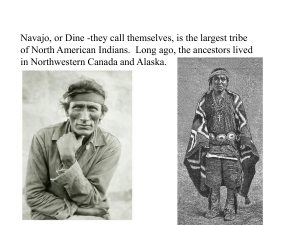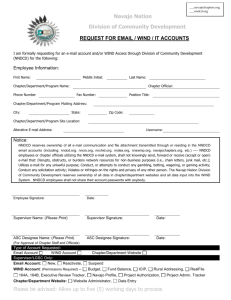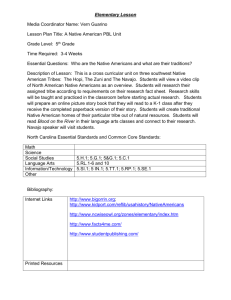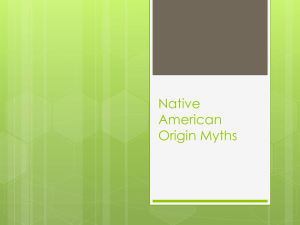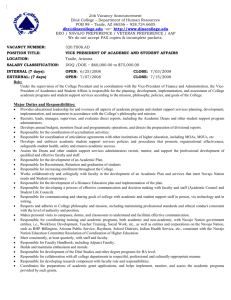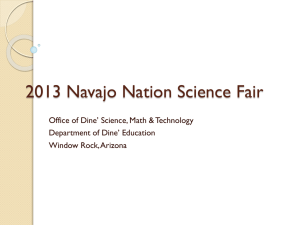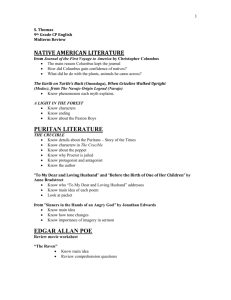Navajo Origin Myth
advertisement
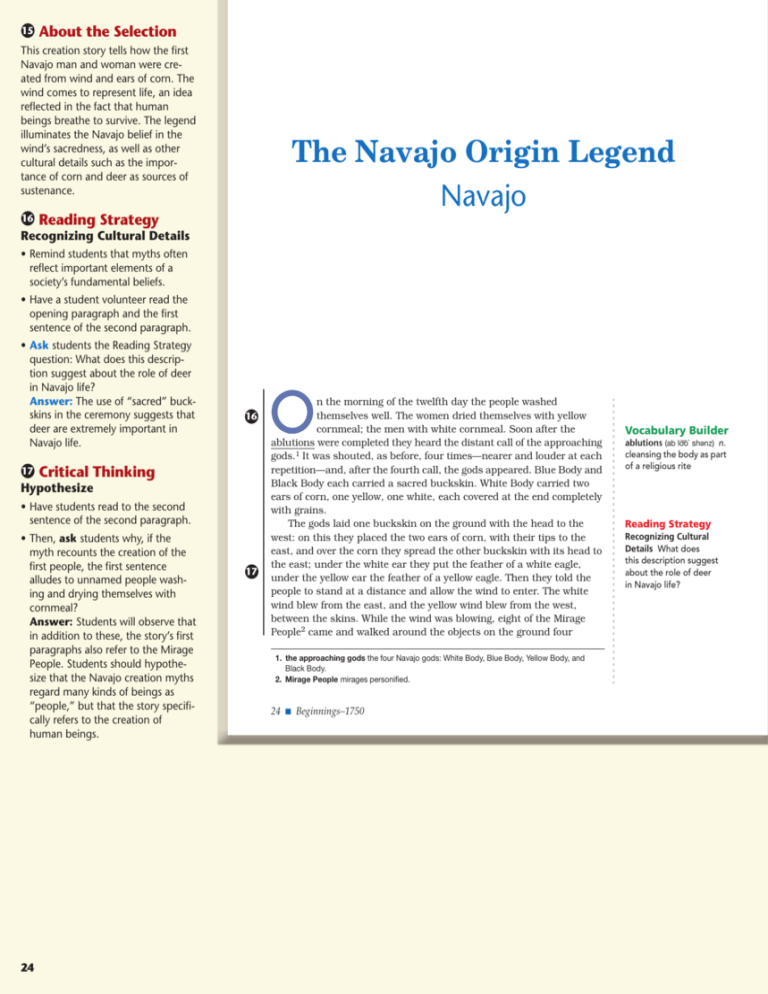
15 About the Selection This creation story tells how the first Navajo man and woman were created from wind and ears of corn. The wind comes to represent life, an idea reflected in the fact that human beings breathe to survive. The legend illuminates the Navajo belief in the wind’s sacredness, as well as other cultural details such as the importance of corn and deer as sources of sustenance. 16 The Navajo Origin Legend Navajo Reading Strategy Recognizing Cultural Details • Remind students that myths often reflect important elements of a society’s fundamental beliefs. • Have a student volunteer read the opening paragraph and the first sentence of the second paragraph. • Ask students the Reading Strategy question: What does this description suggest about the role of deer in Navajo life? Answer: The use of “sacred” buckskins in the ceremony suggests that deer are extremely important in Navajo life. 17 16 Critical Thinking Hypothesize • Have students read to the second sentence of the second paragraph. • Then, ask students why, if the myth recounts the creation of the first people, the first sentence alludes to unnamed people washing and drying themselves with cornmeal? Answer: Students will observe that in addition to these, the story’s first paragraphs also refer to the Mirage People. Students should hypothesize that the Navajo creation myths regard many kinds of beings as “people,” but that the story specifically refers to the creation of human beings. 24 17 n the morning of the twelfth day the people washed themselves well. The women dried themselves with yellow cornmeal; the men with white cornmeal. Soon after the ablutions were completed they heard the distant call of the approaching gods.1 It was shouted, as before, four times—nearer and louder at each repetition—and, after the fourth call, the gods appeared. Blue Body and Black Body each carried a sacred buckskin. White Body carried two ears of corn, one yellow, one white, each covered at the end completely with grains. The gods laid one buckskin on the ground with the head to the west: on this they placed the two ears of corn, with their tips to the east, and over the corn they spread the other buckskin with its head to the east; under the white ear they put the feather of a white eagle, under the yellow ear the feather of a yellow eagle. Then they told the people to stand at a distance and allow the wind to enter. The white wind blew from the east, and the yellow wind blew from the west, between the skins. While the wind was blowing, eight of the Mirage People2 came and walked around the objects on the ground four 1. the approaching gods the four Navajo gods: White Body, Blue Body, Yellow Body, and Black Body. 2. Mirage People mirages personified. 24 � Beginnings–1750 Vocabulary Builder ablutions (ab lØ« shßnz) n. cleansing the body as part of a religious rite Reading Strategy Recognizing Cultural Details What does this description suggest about the role of deer in Navajo life? 18 Literary Analysis Origin Myths • Read aloud with students the story’s next-to-last paragraph. 18 times, and as they walked the eagle feathers, whose tips protruded from between the buckskins, were seen to move. When the Mirage People had finished their walk the upper buckskin was lifted; the ears of corn had disappeared, a man and a woman lay there in their stead. The white ear of corn had been changed into a man, the yellow ear into a woman. It was the wind that gave them life. It is the wind that comes out of our mouths now that gives us life. When this ceases to blow we die. In the skin at the tips of our fingers we see the trail of the wind; it shows us where the wind blew when our ancestors were created. The pair thus created were First Man and First Woman (Atsé Hastin and Atsé Estsán). The gods directed the people to build an enclosure of brushwood for the pair. When the enclosure was finished, First Man and First Woman entered it, and the gods said to them: “Live together now as husband and wife.” Vocabulary Builder protruded (prò trØd« id) v. jutted out Literary Analysis Origin Myths Why might the Navajo have viewed the wind as the source of life? • Ask students the Literary Analysis question: Why might the Navajo have viewed the wind as the source of life? Answer: The wind is a major climatic force, so the Navajo may have come to ascribe many powers to the wind. Also, since breath and wind are both movements of air, and since breath sustains human and animal life, it makes sense to compare wind to breath. Answers 1. The impressions created by the works will vary from tale to tale and student to student. 2. (a) They take in his daughter and marry her to their oldest son. (b) It reveals that he is proud as creator of the Earth and does not want to share his powers of creation. Critical Reading 1. Respond: What words would you use to describe the images in these tales and the impression they made on you? 2. (a) Recall: What do the grizzly bears do that angers the Chief of the Sky Spirit? (b) Analyze: What does his reaction tell you about him? 3. (a) He forbids them to talk or to walk upright. (b) His action causes his grandchildren, the first Indians, to scatter and wander over the Earth. 3. (a) Recall: What punishment does the Chief of the Sky Spirits levy against the grizzlies? (b) Analyze Cause and Effect: How does this action affect his grandchildren, the people of the Earth? 4. (a) Recall: Identify the stages of the Navajo creation ceremony. (b) Analyze: What do the order and ritual of the ceremony tell you about the Navajo people? 5. (a) Recall: What is the wind’s role in the ceremony? (b) Contrast: How does the wind’s role contrast with the order and ritual of the ceremony? 6. (a) Compare and Contrast: In what ways do the two tales differ in their attitude toward nature? (b) Evaluate: With which attitude do you most identify? Why? For: More about the Modoc and Navajo Visit: www.PHSchool.com Web Code: ere-9111 from The Navajo Origin Legend ■ 25 Strategy for English Learners Enrichment for Gifted/Talented Students Draw students’ attention to the items in the story that function as symbols. Encourage students to list the items––buckskins, ears of corn, and eagle feathers, as well as the colors white, yellow, blue, and black. On the lists, have students jot suggested explanations of the significance of these items to the Navajo. Encourage students to research Native Americans’ use of symbolism in other arts. For example, interested students might study the meanings of totems––carved and painted images on vertically mounted logs––that are constructed by the Indians of the Northwest Coast of the United States and Canada. For additional information about the Modoc and the Navajo, have students type in the Web Code, then select M or N from the alphabet, and then select Modoc or Navajo. 4. (a) First stage—the spirit people cleanse and dry themselves and call forth the gods; second—gods appear and place corn and feathers on buckskin; third—Mirage People circle buckskins, wind blows and transforms ears into people. (b) The Navajo people value and rely on a sense of order and ritual in life. 5. (a) The wind transforms the ears of corn into human beings. (b) The wind’s work is “magical,” in contrast to the logical and precise actions taken by the spirit people in anticipation of the wind’s arrival. 6. (a) The Navajo legend does not explain the formation of the Earth. Although animals play a key role in bringing human life to Earth in the first two myths, vegetation (corn) is the key to life in the Navajo tale. (b) Students’ responses will vary and should be supported with references to one or more texts. 25

